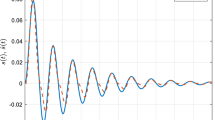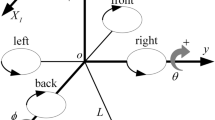Abstract
Active queue management (AQM) is aimed at achieving the tradeoff between link utilization and queuing delay to enhance TCP congestion control and is expected to perform well for a wider-range of network conditions. Static AQM schemes despite their simplicity, often suffer from long response time due to conservative parameter setting to ensure stability. Adaptive parameter settings, which might solve this problem, remain difficult from implementation point of view. In this paper, we propose an adaptive fuzzy sliding mode (AFSM) AQM algorithm to achieve fast response and yet good robustness. The AFSM algorithm uses the queue length and its differential as the input of AQM and adjusts fuzzy rules by the measurement of packet loss ratio dynamically. The stability analysis under heterogeneous round trip times provides guidelines for parameter settings in AFSM and guarantees that the stability of AFSM is independent of the active TCP flows. This merit as well as other performances is examined under various network environments. Compared to some typical AQMs, the AFSM algorithm trades off the throughput with queuing delay better and achieves a higher per-flow throughput. Finally, AFSM can be executed at a scale of seconds with the least fuzzy rules.
Similar content being viewed by others
References
Altman, E., & Jiménez, T. (2004). Simulation analysis of RED with short lived TCP connections. Computer Networks, 44, 631–641.
Alpcan, T., & Başar, T. (2005). A globally stable adaptive congestion control scheme for Internet-style networks with delay. IEEE/ACM Transactions on Networking, 13(6), 1261–1274.
Athuraliya, S., Low, S. H., Li, V. H., & Yin, Q. (2001). REM: active queue management. IEEE Network, 15(3), 48–53.
Başar, T., & Olsder, G. J. (1999). Dynamic noncooperative game theory (2nd ed.). Philadelphia: SIAM.
Chen, Q., & Yang, O. W. W. (2004). On designing self-tuning controllers for AQM routers supporting TCP flows based on pole placement. IEEE Journal on Selected Areas in Communications, 22, 1965–1974.
Choi, B.-J., Kwak, S.-W., & Kim, B. K. (2000). Design and stability analysis of single-input fuzzy logic controller. IEEE Transactions on Systems, Man and Cybernetics, Part B: Cybernetics, 30(2), 303–309.
Feng, W.-C., Kandlur, D., Saha, D., & Shin, K. (1999). A self-configuring red gateways. In Proceedings of IEEE Infocom (Vol. 3, pp. 1320–1328).
Feng, W.-C., Shin, K. G., Kandalur, D. D., & Saha, D. (2002). The BLUE active queue management algorithms. IEEE/ACM Transactions on Networking, 10(4), 513–528.
Floyd, S., & Jacobson, V. (1993). Random early detection gateways for congestion avoidance. IEEE/ACM Transactions on Networking, 1(4), 397–413.
Floyd, S. http://www.aciri.org/floyd/Redparameters.txt.
Floyd, S. (2000). Recommendation on using the gentle variant of RED. http://www.icir.org/floyd/red.html.
Floyd, S., Gummadi, R., & Shenker, S. Adaptive RED: an algorithm for increasing the robustness of RED’s active queue management. http://www.icir.org/floyd/adaptivered/.
Gao, Y., & Hou, J. C. (2003). A state feedback control approach to stabilizing queues for ECN-enabled TCP connections. In Proceedings Infocom (Vol. 3, pp. 2301–2311).
Han, H., Hollot, C. V., Chait, Y., & Misra, V. (2004). TCP networks stabilized by buffer-based AQMs. In Proceedings of IEEE Infocom’04 (Vol. 2, pp. 964–974).
Hollot, C. V., Misra, V., Towsley, D., & Gong, W. (2001). A control theoretic analysis of RED. In Proceedings of IEEE Infocom (Vol. 3, pp. 1510–1519).
Hollot, C. V., Misra, V., Towsley, D., & Gong, W. (2001). On designing improved controllers for AQM routers supporting TCP flows. In Proceedings of IEEE Infocom (Vol. 3, pp. 1726–1734).
Hollot, C. V., Misra, V., Towsley, D., & Gong, W. (2002). Analysis and design of controllers for AQM routers supporting TCP flows. IEEE Transactions on Automatic Control, 47(6), 945–959.
Jacobson, V., & Karels, M. (1988). Congestion avoidance and control. In Proceedings of ACM Sigcomm (Vol. 18, pp. 314–329).
Kamra, A., Saran, H., Sen, S., & Shorey, R. (2004). Fair adaptive bandwidth allocation: a rate control based active queue management discipline. Computer Networks, 44(2), 135–152.
Kelly, F. P., Maulloo, A., & Tan, D. (1998). Rate control in communication networks: shadow prices, proportional fairness and stability. Journal of the Operational Research Society, 49, 237–252.
Kelly, F. (2001). Mathematical modelling of the Internet. In B. Engquist & W. Schmid (Eds.), Mathematics unlimited—2001 and beyond. Berlin: Springer.
Kunniyur, S., & Srikant, R. (2004). An adaptive virtual queue (AVQ) algorithm for active queue management. IEEE/ACM Transactions on Networking, 12(2), 286–299.
Li, H.-X. (1999). Relationship between fuzzy controllers and PID controllers. Science in China (Series E), 29(2), 136–145.
Lin, W. K., Wong, K. Y., & Dillon, T. S. (2006). Application of soft computing techniques to adaptive user buffer overflow control on Internet. IEEE Transactions on Systems, Man and Cybernetics, Part C: Applications and Reviews, 36(3), 397–410.
Liu, S., Başar, T., & Srikant, R. (2005). Exponential-RED: a stabilizing AQM scheme for low- and high-speed TCP protocols. IEEE/ACM Transactions on Networking, 13(5), 286–299.
Liu, S., Başar, T., & Srikant, R. (2005). Pitfalls in the fluid modeling of RTT variations in window-based congestion control. In Proceedings of IEEE Infocom’05 (Vol. 2, pp. 1002–1012).
Low, S. H., Paganini, F., & Doyle, J. C. (2002). Internet congestion control. IEEE Control System Magazine, 22, 28–43.
Low, S. H., Paganini, F., Wang, J., & Doyle, J. C. (2003). Linear stability of TCP/RED and a scalable control. Computer Networks, 43, 633–647.
Misra, V., Gong, W., & Towsley, D. (2000). A fluid-based analysis of a network of AQM routers supporting TCP flows with an application of RED. In Proceedings of ACM Sigcomm’00, Stockholm, Sweden
Ott, T. J., Lakshman, T. V., & Wong, L. (1999). SRED: stabilized RED. In Proceedings IEEE Infocom’99 (Vol. 3, pp. 1346–1355).
Paganini, F., Wang, Z., Doyle, J. C., & Low, S. H. (2005). Congestion control for high performance, stability, and fairness in general networks. IEEE/ACM Transactions on Networking, 13(1), 43–56.
Palm, R. (1994). Robust control by fuzzy sliding mode. Automatica, 30(9), 1429–1437.
Park, E.-C., Lim, H., Park, K.-J., & Choi, C.-H. (2004). Analysis and design of the virtual rate control algorithm for stabilizing queues in TCP networks. Computer Networks, 44, 17–41.
Ren, F., Ren, Y., & Shan, X. (2002). Design of a fuzzy controller for active queue management. Computer Communications, 25(9), 874–883.
Ryu, S., Rump, C., & Qiao, C. (2004). Advances in active queue management (aqm) based tcp congestion control. Telecommunication Systems, 25, 317–351.
Trinh, T. A., & Molnár, S. (2004). A comprehensive performance analysis of random early detection mechanism. Telecommunication Systems, 25(1–2), 9–31.
UCB, LBNL. VINT network simulator. http://www-mash.cs.berkeley.edu/ns/.
Vinnicombe, G. (2002). On the stability of networks operating TCP-like congestion control. In Proceedings 15th IFAC world congress on automatic control, Barcelona, Spain.
Wang, C., Li, B., Sohraby, K., & Peng, Y. (2003). AFRED: an adaptive fuzzy-based control algorithm for active queue management. In Proceedings of IEEE LCN (pp. 12–20)
Wen, J. T., & Arcak, M. (2004). A unifying passivity framework for network flow control. IEEE Transactions on Automatic Control, 49(2), 162–174.
Yaiche, H., Mazumdar, R. R., & Rosenberg, C. (2000). A game theoretic framework for bandwidth allocation and pricing in broadband networks. IEEE/ACM Transactions on Networking, 8(5), 667–678.
Yan, P., Gao, Y., & Özbay, H. (2005). A variable structure control approach to active queue management for TCP with ECN. IEEE Transactions on Control System Technology, 13(12), 203–215.
Yang, B., Guan, X., Zhao, B., & Chen, C. (2004). Fuzzy sliding mode control algorithm for networks operating TCP-like congestion control. In Proceedings of IEEE international symposium on intelligent control (pp. 19-24), Taipei, Taiwan.
Zhang, H., Hollot, C. V., Towsley, D., & Misra, V. (2003). A self-tuning structure for adaptation in TCP/AQM networks. In Proceedings of IEEE Globecom (Vol. 7, pp. 3641–3646).
Author information
Authors and Affiliations
Corresponding author
Additional information
This work was supported in part by the Research Grants Council of Hong Kong SAR, P.R. China, under Grant Cityu 112806, National Outstanding Youth Foundation under grant No. 60525303, NSFC under grant No. 60404022, 60604012 and the NSF of Hebei Province under grant No. F2005000390, F2006000270.
Rights and permissions
About this article
Cite this article
Guan, X., Yang, B., Zhao, B. et al. Adaptive fuzzy sliding mode active queue management algorithms. Telecommun Syst 35, 21–42 (2007). https://doi.org/10.1007/s11235-007-9040-6
Published:
Issue Date:
DOI: https://doi.org/10.1007/s11235-007-9040-6




